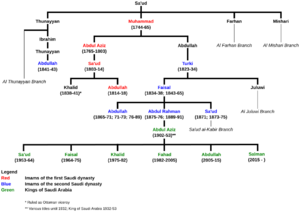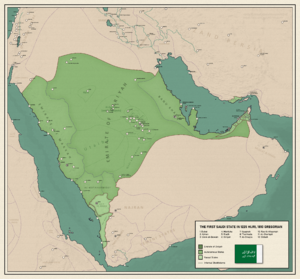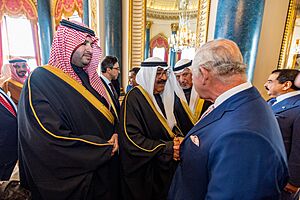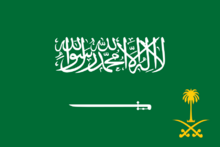House of Saud facts for kids
Quick facts for kids House of Saudآل سعود
|
|
|---|---|
| Royal house | |
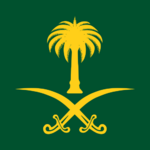
|
|
| Parent family | Al-Muqrin of house of Al-Muraydi of the Diriyah (1446) of Banu Hanifa of Banu Bakr bin Wa'il |
| Country | Saudi Arabia (current) Historical:
|
| Founded | 1720 |
| Founder | Saud I (died 1725) |
| Current head | Salman |
| Titles |
|
| Traditions | Sunni Islam |
The House of Saud (Arabic: آل سُعُود, romanized: ʾĀl Suʿūd) is the royal family that rules Saudi Arabia. This family includes the descendants of Muhammad bin Saud, who founded the Emirate of Diriyah (1727–1818), also known as the First Saudi State. The main leaders of the family today are mostly descendants of Ibn Saud, who founded modern Saudi Arabia.
The House of Saud is part of the larger Banu Hanifa tribe from ancient Arabia. The most important role in the royal family is the King of Saudi Arabia, who is an absolute ruler. There are about 15,000 members in the family, but only about 2,000 of them hold most of the power, influence, and wealth. Some experts believe the family's total wealth is around $1.4 trillion. This includes the value of Saudi Aramco, the state oil company, and its huge oil reserves. This makes them one of the wealthiest families in the world.
The House of Saud's history has four main parts:
- The Sheikhdom of Diriyah (1446–1744)
- The Emirate of Diriyah (1727–1818), which saw the spread of Salafism
- The Emirate of Nejd (1824–1891), a time of many internal conflicts
- The current state (1902–present), which became the Kingdom of Saudi Arabia in 1932. This kingdom now has a lot of power in the Middle East.
The family has faced challenges from the Ottoman Empire, the Sharif of Mecca, and the Al Rashid family. They have also had conflicts with various Islamist groups and the Shia minority in Saudi Arabia.
The way the Saudi Arabian throne is passed down was designed to go from one son of the first king, Ibn Saud, to another. Until 2006, the monarchy was hereditary, meaning it passed to the oldest male relative. In 2006, a royal decree changed this so that future kings would be chosen by a committee of Saudi princes. The current king, King Salman, first chose his nephew Muhammad bin Nayef as crown prince. In 2017, Mohammed bin Salman, King Salman's son, became the crown prince after a vote by the Allegiance Council. The king's cabinet also includes many members of the royal family.
Contents
Understanding the House of Saud Name
The name House of Saud comes from the Arabic name ʾĀl Saud. The word ʾĀl means "family of" or "House of." It is added to the name of an ancestor. For the Al Saud family, this ancestor is Saud bin Muhammad bin Muqrin, who was the father of the family's founder, Muhammad bin Saud.
Anyone who is a descendant of Muhammad bin Saud or his three brothers (Farhan, Thunayyan, and Mishari) carries the surname "Al Saud." Other family branches, like Saud Al Kabir, Al Jiluwi, Al Thunayan, Al Mishari, and Al Farhan, are called cadet branches. Members of these cadet branches hold important government jobs, even though they are not in line to become king. Many cadet members marry into the main Al Saud family to keep their connections and influence in the government.
All male members of the royal family are called Emir (Prince). The sons and grandsons of kings are called "His Royal Highness" (HRH). Great-grandsons and members of cadet branches are called "His Highness" (HH). The reigning king also uses the special title "Custodian of the Two Holy Mosques."
History of the Saudi Royal Family
Early Beginnings
The first known ancestor of the Al Saud family was Mani' ibn Rabiah Al-Muraydi. He settled in Diriyah in 1446–1447 with his clan, the Mrudah. The Mrudah are believed to be from the Banu Hanifa tribe, which was important in the Middle East from the 6th century.
Mani' was invited to Diriyah by a relative, Ibn Dir, who ruled some villages near modern-day Riyadh. Mani's clan had been living in eastern Arabia for some time. Ibn Dir gave Mani two estates, and Mani's family settled there, renaming the area Al Diriyah after Ibn Dir.
The Mrudah became the rulers of Al Diriyah, which grew and became an important settlement. As the clan grew, some members moved away, but the Al Muqrin family became the main rulers in Diriyah. The family's name comes from Sheikh Saud ibn Muhammad ibn Muqrin, who passed away in 1725.
The First Saudi State
The First Saudi State began in 1727. During this time, the state expanded its territory and was driven by strong religious beliefs. At its largest, the First Saudi State covered most of what is now Saudi Arabia. Its allies even raided areas in Yemen, Oman, Syria, and Iraq. Religious scholars, especially Muhammad ibn Abdul Wahhab, played a big role in Saudi rule. The Saudis and their allies called themselves Muwahhidun (monotheists). Later, they were called Wahhabis, a strict Islamic group named after its founder.
Leadership in the First Saudi State passed from father to son smoothly. Muhammad bin Saud was followed by his oldest son, Abdulaziz, in 1765. In 1802, Abdulaziz's forces attacked the holy city of Karbala in what is now Iraq. They caused damage and took many valuable items.
This attack made the Ottomans and Egyptians see the Saudis as a threat. Abdulaziz passed away in 1803. His son, Saud, then became ruler, and the Saudi state reached its largest size under him. When Saud passed away in 1814, his son Abdullah bin Saud had to fight an Ottoman-Egyptian invasion in the Wahhabi war. The Egyptian forces defeated Abdullah's army and captured the Saudi capital of Diriyyah in 1818. Abdullah was taken prisoner and later passed away, ending the First Saudi State. The Egyptians sent many Al Saud family members to Egypt and Constantinople and destroyed Diriyyah.
The Second Saudi State
A few years after Diriyah fell in 1818, the Saudis regained control in Najd. They established the Emirate of Nejd, also known as the Second Saudi State, with its capital in Riyadh.
This second period saw less expansion and less religious fervor compared to the first state. However, the Saudi leaders still used the title imam and worked with Salafi religious scholars. The Second Saudi State also had many internal conflicts within the Saudi family, which eventually led to its downfall. Most successions happened through conflict or civil war.
Modern Saudi Arabia


After a defeat at Mulayda, Abdul Rahman bin Faisal went into exile in eastern Arabia. He later found safety in Kuwait with the Kuwaiti emir, Mubarak Al Sabah. In 1902, Abdul Rahman's son, Abdulaziz, decided to bring back Saudi rule in Riyadh. With a small group of followers, Abdulaziz captured Riyadh's Masmak fort and became the ruler of Riyadh. From then on, Abdulaziz became known as "Ibn Saud" in Western countries, though he is still called "Abdulaziz" in the Arab world.
Ibn Saud spent the next thirty years working to restore his family's rule over central Arabia. His main rivals were the Al Rashid clan, the Sharifs of Mecca, and the Ottoman Turks. Ibn Saud also had to deal with other family members who claimed the throne. He allied with the British against the Ottoman-backed Al Rashidis. From 1915 to 1927, Abdulaziz's lands were a protectorate of the British Empire.
Ibn Saud finally defeated the Al Rashidis in 1921, becoming the ruler of most of central Arabia. He united his lands as the Sultanate of Nejd. He then conquered the Hijaz in 1926. For the next five and a half years, he ruled these two parts as separate areas, called the Kingdom of Hejaz and Nejd.
By 1932, Ibn Saud had overcome all his main rivals and united his lands into the Kingdom of Saudi Arabia. His father, Abdul Rahman, kept the honorary title of "imam." In 1937, huge oil reserves were discovered near Dammam. Before oil was found, many family members were not wealthy.
Ibn Saud had many children with his wives. He married into many noble clans and tribes in his territory. He also arranged similar marriages for his sons and relatives. He named his oldest living son, Saud, as his heir apparent, to be followed by his next oldest son, Faisal. The Al Saud family became known as the "royal family," and all male members were called amir (prince) and female members amira (princess).
Ibn Saud passed away in 1953, after forming an alliance with the United States in 1945. He is still officially celebrated as the "Founder." Only his direct descendants can use the title "his or her Royal Highness." The date he recaptured Riyadh in 1902 was chosen to mark Saudi Arabia's centennial in 1999.
After Ibn Saud's death, his son Saud became king. However, Saud's spending led to a power struggle with his brother, Crown Prince Faisal. In 1964, the royal family asked Saud to step down in favor of Faisal. Some of Ibn Saud's younger sons, known as the "Free Princes," wanted reforms and went to Egypt, but Faisal later convinced them to return. They were pardoned but could not hold government positions again.
Faisal passed away in 1975. Another brother, Khalid, became king. The next in line had been Prince Muhammad, but he gave up his claim to the throne for Khalid.
Khalid passed away in 1982 and was followed by Fahd. Fahd was the oldest of the powerful "Sudairi Seven," who were all sons of Ibn Saud by his wife Hassa Al Sudairi. In 1986, Fahd changed the royal title from "his Majesty" to "Custodian of the Two Holy Mosques," referring to the holy sites in Mecca and Medina.
In 1995, Fahd became largely unable to rule due to illness. His half-brother, Crown Prince Abdullah, gradually took over most of the king's duties until Fahd's death in August 2005. Abdullah became king and appointed his younger brother, Sultan bin Abdulaziz, as the new heir. Sultan passed away in October 2011, and Prince Nayef became crown prince. Nayef also passed away in June 2012. On January 23, 2015, Abdullah passed away, and his half-brother, Crown Prince Salman, became the new king.
In 2017, many princes and government officials were arrested in an anti-corruption campaign by the king and crown prince.
How the Royal Family Holds Power

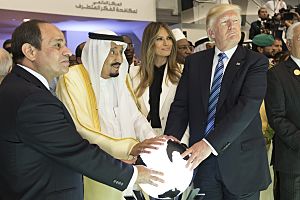
The leader of the House of Saud is the King of Saudi Arabia. He is the Head of State and monarch. The king has almost complete political power. He chooses ministers for his cabinet, who manage their departments in his name. Important ministries like Defence, Interior, and Foreign Affairs are usually led by members of the Saud family. All thirteen regional governors are also from the family. However, other roles, like Finance or Oil Affairs, are often given to people not from the royal family, with younger Al Saud members as their assistants. Royal family members also hold many key military and government jobs. The Al Saud family has always held the ultimate power, but support from religious scholars, business people, and the general public is important for them to stay in power.
Long-term government jobs have created "power areas" for senior princes. For example, King Faisal was foreign minister for a long time. King Abdullah was commander of the National Guard for many years. Former Crown Prince Sultan bin Abdulaziz was minister of defence and aviation. Former Crown Prince Nayef bin Abdul Aziz was the minister of interior. Prince Saud was minister of foreign affairs. King Salman was governor of the Riyadh Province before becoming king. The current minister of defense is Prince Mohammad bin Salman, King Salman's son and the current crown prince.
These long terms in office have allowed senior princes to mix their personal wealth with the money from their departments. They often appoint their own sons to important positions within their areas. For example, Prince Mutaib bin Abdullah was an assistant commander in the National Guard. Prince Khalid bin Sultan was an assistant minister of defence. In departments with large budgets, younger brothers are often appointed as deputies to share the responsibilities and wealth.
Unlike Western royal families, the Saudi monarchy has not always had a clear order of who becomes king next. Historically, when a king took the throne, he would name an heir apparent (crown prince). When the king passed away, the crown prince would become king. If the king was unable to rule, the crown prince would take over as regent. While other Al Saud members hold political jobs, only the king and crown prince are legally considered the main political leaders.
The royal family has different groups based on family ties, personal goals, and different ideas. The most powerful group is the 'Sudairi Seven', which includes the late King Fahd, his full brothers, and their descendants. There are also disagreements within the family about how fast and in what direction reforms should happen, and whether the role of religious scholars should increase or decrease. There were also disagreements about who should become king after Prince Sultan passed away. When Prince Sultan passed away in October 2011, King Abdullah appointed Prince Nayef as crown prince. The next year, Prince Nayef also passed away.
Who Becomes King Next?
Since the death of the founder of modern Saudi Arabia, the throne has passed from brother to brother. Abdulaziz was followed by his son Saud, who was followed by his half-brother Faisal. Faisal was followed by his brother Khalid, who was then followed by his half-brother Fahd. Fahd was followed by his half-brother Abdullah, and Abdullah by his half-brother Salman, who is the current King. In January 2015, Salman appointed his half-brother Muqrin as Crown Prince, but removed him in April 2015. Even Abdulaziz's youngest son was 70 years old in 2015. Abdulaziz had said in 1920 that future succession would be from brother to brother, not from father to son.
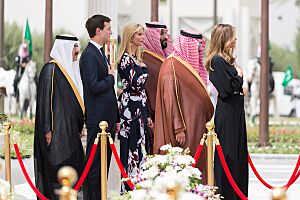
King Salman changed the brother-to-brother succession. In April 2015, he appointed his 56-year-old nephew Muhammad bin Nayef as crown prince. This meant the next succession would be from uncle to nephew. At the same time, King Salman appointed his son, Mohammad bin Salman, as deputy crown prince. This meant the next succession would be from cousin to cousin. However, in June 2017, Salman made Mohammad bin Salman the crown prince, removing Muhammad bin Nayef from all his positions. This made his son the next in line to the throne, marking the first time since 1953 that the succession would go from father to son.
There have been some concerns within the Saudi royal family about the crown prince becoming the next king. It was reported that some princes were interested in Prince Ahmed becoming king instead. Prince Ahmed had also expressed some criticism of the Saudi leadership during a visit to London. He was also one of three family members who did not support Mohammad bin Salman becoming crown prince in 2017.
The Royal Family's Wealth
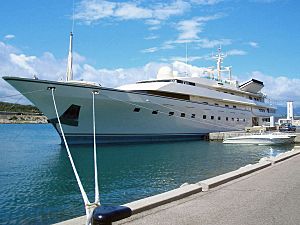
In June 2015, Forbes magazine listed Prince Al-Waleed bin Talal, a grandson of Abdulaziz, as the 34th richest person in the world. His estimated wealth was US$22.6 billion.
As of 2020, the total wealth of the entire royal family is estimated to be around US$100 billion. This makes them the richest royal family among all monarchs and one of the wealthiest families globally. Some estimates suggest their wealth could be as high as $1.4 trillion, including their shares in Saudi Aramco.
Leaders of the House of Saud
Emirate of Diriyah Leaders
| Name | Lifespan | Reign start | Reign end | Notes | Family | Image |
|---|---|---|---|---|---|---|
Saud I
|
1640 – 1725 |
1720 | 1725 (died naturally) |
The ancestor the House of Saud is named after. Son of Emir Muhammad bin Muqrin |
Muqrin |
First Saudi State Leaders
| Name | Lifespan | Reign start | Reign end | Notes | Family | Image |
|---|---|---|---|---|---|---|
Muhammad I
|
1687 – 1765 |
1744 | 1765 (died naturally) |
Started his rule by conquest. Son of Emir Saud I |
Saud |  |
Abdul-Aziz I
|
1720 – 1803 |
1765 | 12 November 1803 (passed away) |
Son of Imam Muhammad I and Mody bint Sultan Al Kathiri | Saud | |
Saud II
|
1748 – 1814 |
1803 | April 1814 (died naturally) |
Son of Imam Abdul-Aziz I and Al-Jawhara bint Othman Al Muammar | Saud | |
Abdullah I
|
1785 – 1818 |
1814 | Died May 1819 (executed by the Ottoman Empire) |
Son of Imam Saud II The last ruler of the First Saudi State |
Saud |  |
Second Saudi State Leaders
| Name | Lifespan | Reign start | Reign end | Notes | Family | Image |
|---|---|---|---|---|---|---|
1 Turki
|
1755 – 1834 |
1824 | 1834 (passed away) |
Founder of the Second Saudi State. Son of Prince Abdullah bin Muhammad Al Saud |
Saud | |
2 Mishari
|
1786 – 1834 |
1824 (ruled for 40 days) | 1834 (executed) |
Son of Prince Abdul Rahman bin Hassan bin Mishari Al Saud | Saud | |
3 and 6 Faisal I
|
1785 – 1865 |
1834–1838 (first time) 1843–1865 (second time) |
1865 (died naturally) |
Son of Imam Turki and Haya bint Hamad bin Ali Al-Anqari Al-Tamimi | Saud | |
4 Khalid I
|
1811 – 1865 |
1838 | 1841 (removed from power) |
Distant cousin. Son of Imam Saud II | Saud | |
5 Abdullah II
|
? – July 1843 |
1841 | 1843 (removed from power) |
Distant cousin. Son of Prince Thunayan bin Ibrahim bin Thunayan bin Saud | Saud | |
7 and 9 and 12 Abdullah III
|
1831 – 2 December 1889 |
1865–1871 (first time) 1871–1873 (second time) 1876–1889 (third time) |
1889 (died naturally) |
Son of Imam Faisal I and Haya bint Hamad bin Ali Al-Anqari Al-Tamimi | Saud | |
8 and 10 Saud III
|
1833 – 1875 |
1871 (first time) 1873–1875 (second time) |
1889 (died naturally) |
Son of Imam Faisal I and Dashisha bint Didan bin Mandeel Al-Omari Al-Khalidi | Saud | |
11 and 13 Abdul-Rahman
|
1850 – 1925 |
1875–1876 (first time) 1889–1891 (second time) |
1891 (His rule ended) |
Son of Imam Faisal I and Sarah bint Mashari bin Abdulrahman Al Saud The last ruler of the Second Saudi State |
Saud |  |
Third Saudi State Leaders (Kings of Saudi Arabia)
| Name | Lifespan | Reign start | Reign end | Notes | Family | Image |
|---|---|---|---|---|---|---|
Abdul-Aziz II
|
15 January 1875 – 9 November 1953 (aged 78) |
13 January 1902 (aged 27) | 9 November 1953 (died naturally) |
Started his rule by conquest. Son of Imam Abdul Rahman and Sara bint Ahmed Al Sudairi |
Saud |  |
Saud IV
|
12 January 1902 – 23 February 1969 (aged 67) |
9 November 1953 (aged 51) | 2 November 1964 (stepped down) |
Son of King Abdulaziz and Wadha bint Muhammad Al Orair | Saud |  |
Faisal II
|
14 April 1906 – 25 March 1975 (aged 68) |
2 November 1964 (aged 58) | 25 March 1975 (passed away) |
Son of King Abdulaziz and Tarfa bint Abdullah Al Sheikh | Saud |  |
Khalid II
|
13 February 1913 – 13 June 1982 (aged 69) |
25 March 1975 (aged 62) | 13 June 1982 (died naturally) | Son of King Abdulaziz and Al Jawhara bint Musaed bin Jiluwi Al Saud | Saud |  |
Fahd
|
16 March 1921 – 1 August 2005 (aged 84) | 13 June 1982 (aged 61) | 1 August 2005 (died naturally) | Son of King Abdulaziz and Hussa bint Ahmed Al Sudairi | Saud |  |
Abdullah IV
|
1 August 1924 – 23 January 2015 (aged 90) |
1 August 2005 (aged 81) | 23 January 2015 (died naturally) | Son of King Abdulaziz and Fahda bint Asi Al Shuraim | Saud |  |
Salman
|
31 December 1935 | 23 January 2015 (aged 79) | Incumbent | Son of King Abdulaziz and Hussa bint Ahmed Al Sudairi The current ruler of the Third Saudi State | Saud |  |
Notable Current Members
Sons of King Abdulaziz
Here are some of King Abdulaziz's living sons, besides the current King Salman:
- Abdul llah bin Abdulaziz (born 1939) – He used to be the governor of Al Jawf Province. He was a special advisor to King Abdullah from 2008 to 2015.
- Ahmed bin Abdulaziz (born 1942) – He was the deputy minister of interior from 1975 to 2012, and then minister of interior from June to November 2012.
- Mashhur bin Abdulaziz (born 1942)
- Muqrin bin Abdulaziz Al Saud (born 1945) – He was the director general of the General Intelligence Directorate from 2005 to 2012. He also served as governor of Ha'il and Madinah provinces. He was appointed second deputy prime minister in 2013 and became crown prince in 2015 when King Salman took the throne. In April 2015, Muqrin stepped down from his role.
Family Tree
Timeline of Rulers
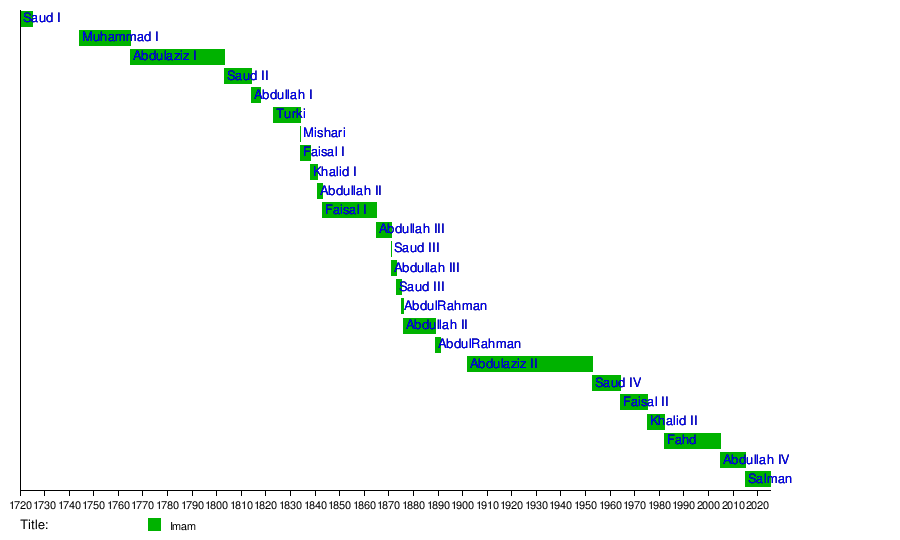
Royal Standard (Flag)
- The Royal Flag is green. It has an Arabic writing and a sword in white. The national emblem is embroidered in gold in the bottom right corner.
- The writing on the flag is in the Thuluth script. It is the shahada, which is the Islamic declaration of faith:
- لَا إِلٰهَ إِلَّا الله مُحَمَّدٌ رَسُولُ الله
- lā ʾilāha ʾillā-allāh, muhammadun rasūlu-allāh
- There is no other god but Allah, Muhammad is the messenger of God.
- The Royal Standard is a green flag with the national emblem embroidered in gold in the center.
Related Topics
- Al ash-Sheikh
- King of Saudi Arabia
- Saudi Royal Guard Regiment


